Megan Kimmel has a long history with shorter-distance trail running in the U.S., including multiple years winning the La Sportiva Mountain Cup race series. This year, she’s expanded into the Skyrunning World series where she has had success on her home soil in the U.S. and abroad. I caught up with Megan to find out a little more about her journey into running and what makes her tick.

Megan Kimmel running the Jupiter Peak Steeplechase in Utah, 2012. Photo: Asics
iRunFar: Megan, you were born in Denver, Colorado. Was it a cool place to grow up?
Megan Kimmel: Yes, I thought Denver was a great place to grow up. There were a lot of parks and an extensive bike path close to my house. Denver has great weather, too, so for a kid that means a lot of time outdoors. Beyond that there was ample opportunity to play sports of all kinds. I loved the city culture of music as a teenager and being amongst a large population. Denver is also great because it is just an hour drive from the mountains, which was definitely influential to me as a kid.
iRunFar: And you were into lots of sports, too–basketball, soccer, and the like. Were there also some outdoor adventures back when you were a kid or did that come later?
Kimmel: Yeah, outside of a childhood filled with soccer, tennis, softball, and basketball, I was lucky to have a chance to go skiing four times a year through my public grade school. Also, my parents loved being outside and I had a grandma with a cabin in the mountains so we spent a lot of spring, summer, and fall weekends up there. In middle and high school, I was always involved with structured school sports but I had friends who skied on the weekends and I was able to enjoy that with them on occasion. I always loved going to the mountains.
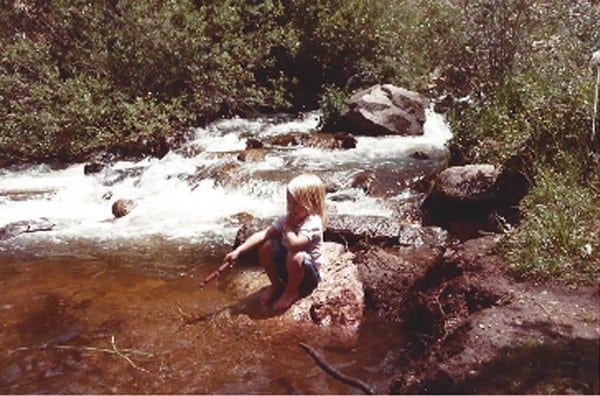
Megan, three years old, gone fishing, 1983. All photos courtesy of Megan Kimmel unless otherwise noted.
iRunFar: Have you been seduced by the skimo trend amongst trail and mountain runners the past few seasons? Is skiing still something that you do a lot of come winter?
Kimmel: Yes, I ski a lot, backcountry skiing has had most of my attention over the years but I have always tried to keep skate skiing as a second, then of course classic Nordic skiing is good early season, for an easy day and also mid-storm. And also, I still like to pull out the telemark set-up for the ski area. It’s more dynamic than alpine skiing when just lapping the area. Telemarking is also really good for the running legs.
I wouldn’t say that I have been seduced by the skimo trend but I have had interest in it as a way to experience the Alps in the wintertime for quite a few years now. I did get my first light set-up last winter and it is way more fun than I was expecting. I wouldn’t take them out on a Colorado powder day but when the conditions are right, it’s really fun to go light, skimo style.
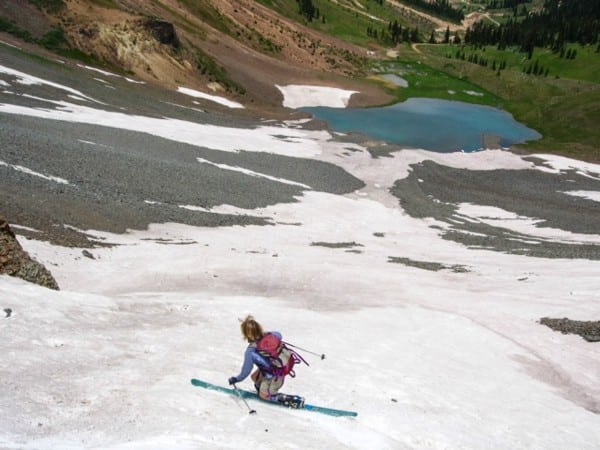
Megan lays down some telemark carves, 2006.
iRunFar: Your journey into running started with cross country in school, right? Was it something that you were good at straight off the bat or did it take a while to find your feet?
Kimmel: I think my journey into running started as a small child. I specifically remember watching the 1984 Olympics on TV, when I was four years old, and wanting to become a runner. I think that desire was satisfied through playing mid-field in soccer growing up. I first really ran in middle school. I remember it was mandatory to run a mile every other Friday and I seemed to do it with ease. I was also on the middle-school track team running the 400, 800, and relays. I had an interesting experience in my final year of middle school in which I ended up missing the final meet of the year because I broke my collarbone earlier that day playing soccer. I often wonder if that incident might have changed my path in sports in some way. Regardless, in high school, track was during the soccer season, and I chose to play soccer. For the fall season, cross country was one of the few sports offered. As a freshman in cross country, I ran my first race JV (at a 5A school) and won. After that I proceeded to letter in cross country all four years but it was nothing that I put much focus or effort into. As one of my soccer coaches said, I was “lacksadaisical.” I think a big part of my attitude was that I didn’t see myself playing sports in college because I had the impression that it would be my whole college experience and I guess I felt like I wanted to have more experiences than that.
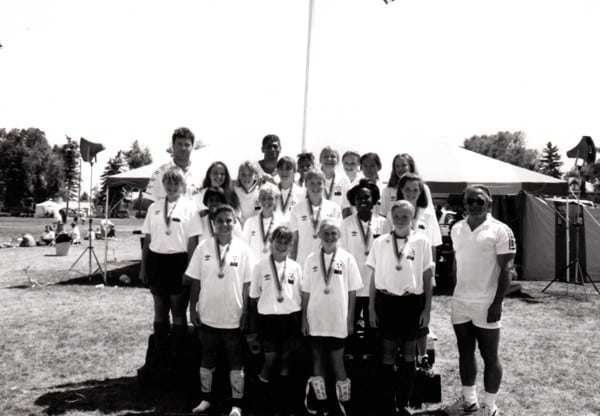
Megan’s soccer team, 1992. Megan is in the second row from the front, third from the left.
iRunFar: Do you think the lackadaisical title was warranted? You come across as someone immensely interested in the world, nature, running. Is there also a go-with-the-flow, insouciant side to you?
Kimmel: I thought it was almost a compliment back then, because it showed that he knew I was capable of more. He was right in the way that I could have applied myself to any of the sports I played to get a scholarship and who knows what else if I chose to. Bottom line is that I was raised with games and sports being for fun and that life is about more than sports. Yes, there is a huge go-with-the-flow side to me but I also rebel, especially when it comes to superficial human-being antics.
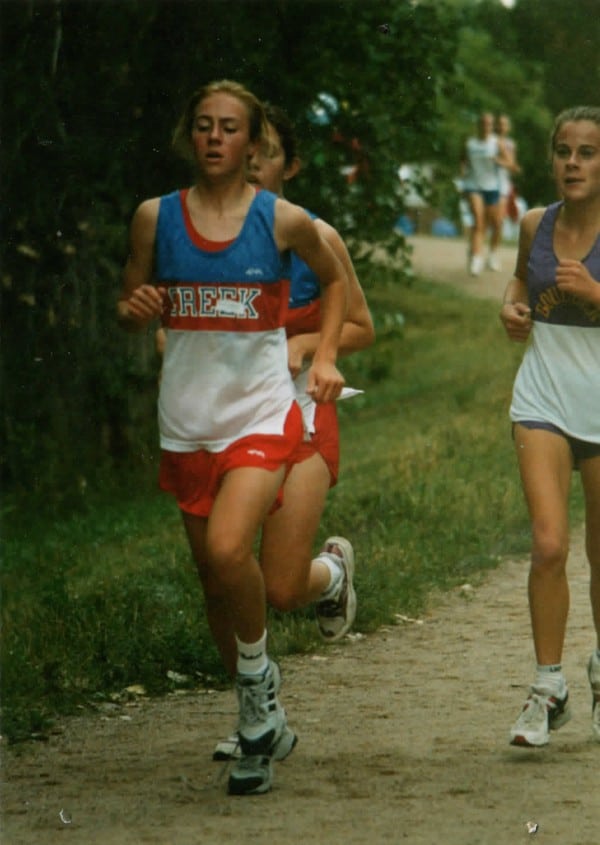
Megan running cross country during her freshman year of high school, 1993.
iRunFar: Apart from sports, what other things did your young self find interesting? Was there a certain subject at school or other pastime that you were passionate about?
Kimmel: Outside of sports I was interested in art, drawing mostly. I didn’t have any natural talent at it but I enjoyed doing it. I remember being interested in the world, I loved looking at National Geographic. Other than that, I was really most interested in friends. I would say I was a typical adolescent just looking to fit in.
iRunFar: University, what did you study and why?
Kimmel: I went to the in-state agriculture university, Colorado State University, to study landscape horticulture as I loved plants, flowers, and trees, and I wanted to design home gardens as a career. Things didn’t really click for me in my first semester. I think I would have been better off at a smaller college. I also really wanted to travel to experience other places so at that point I started doing a lot of semesters abroad as I figured out it wouldn’t cost any more than my normal tuition. I would do a semester somewhere, and then come back to some Colorado mountain town and work to make money for the next one. Within this, my major changed many times and ended in Anthropology.
After my college years I fell straight into the opportunity to study body work/massage therapy, and for the first time in all those academic years, I really enjoyed studying and became a Certified Massage Therapist. For me studying massage opened my eyes to the mind-body connection, which I find fascinating.
iRunFar: It’s interesting you mentioning the mind-body connection. There’s been a lot of talk recently about burnout and overtraining amongst ultrarunners. What’s your opinion on that?
Kimmel: I think the nature of the sport of ultrarunning certainly lends to a higher risk of burnout and overtraining, as you must have a foundation of high mileage in order to complete the ultra distance. High mileage is high risk and it becomes all the more important to pay attention to the little tweaks in the body and getting too carried away with the idea of it in the mind. But there lies the problem, ultrarunning demands that you push your mind and body far past comfort, so I can see it being hard to differentiate symptoms until it is a bigger problem. There are certainly a number of athletes who have illustrated that there are healthy ways to run multiple ultras per year, year after year. And it is important to remember that track athletes are also often sidelined with injury because of the nature of their discipline.
Personally, I have not plunged into ultrarunning as I don’t feel I have the life balance to train for them. Also, the freedom of being able to be active outside everyday is more of a priority to me than completing that long of a distance. Having said that, I look forward to the time when my lifestyle can support running these more distances because it opens the door to more experiences.
iRunFar: You traveled a lot during your university years, Megan. To where did you travel?
Kimmel: After my first semester at university, I moved to ‘the mountains’ of Colorado and after that I studied in Belize, Patagonia, and New Zealand twice. There were bits of travel to the neighboring countries, too. At the end of my last trip I knew I wanted to keep traveling in the future but in order to do so I needed a home base.
iRunFar: Did you have any favourite places that you thought you could call home away from the States?
Kimmel: I returned to New Zealand for a second trip because I thought I wanted to live there. It ended up I got island fever and really missed the vastness of the USA. Being born and raised in Colorado I really have no reason to live anywhere else. It is my favorite place in the world and my family is here.
iRunFar: Back to running. How did your running evolve from cross country in school into being a companion while traveling–what was or is it about the act of running that’s most attractive to you?
Kimmel: After leaving high school I think exercise was so ingrained in me that I didn’t feel good unless I ran. I didn’t have to run everyday but if I didn’t run for a certain amount of time I started to feel lousy. Luckily, running is the one thing you can do practically anywhere without anything extra in your bag so while I was traveling I kept running as I would have at home–assuming I was somewhere safe to run. The most attractive thing about running to me is this aspect of minimal gear and ability to do it just about anywhere. Also it is great bang for your buck as far as time goes.
iRunFar: Can you tell me more about the mountains and trails and your connection to them? I guess growing up in Colorado, there was always this proximity to them and their presence?
Kimmel: I was lucky to have the chance to be in the mountains in my youth. We spent a lot of family time in the mountains. In my middle years I think the mountains provided me with an escape from the adolescent mind. Then in my high school years it became a place of bonding with my friends. Trail running came about slightly later when I spent more time on my own and started having greater urges to be more athletic. Running on trail was just natural progression, merging exploration with fitness. Over the years, trails and running have become an important part of how I ground myself and are also catalysts for my energy, drive in life. Trail running in particular helps me experience the natural world which I think is a very important teacher. It takes me out of my physical body into what life really is.
iRunFar: Nice. As far as running and racing goes, what are some of the highlights, races, or defining moments that stand out as crucial to your development?
Kimmel: The first highlight was a top finish when I was 20 years old at the local race, GoldenLeaf Half Marathon in Aspen/Snowmass, Colorado. From this finish I was offered a job at the Nordic Ski Centre, which fueled my desire to be an athlete. After that it was quite a few years later that racing meant anything to me. I would go to a citizen race once a year and finish top three but I didn’t care much. It’s interesting, because I actually did want to be a ‘professional’ athlete in life but I was more focused on establishing a foundation for my future and learning about a lot of subjects outside of running. I think in your early twenties, life moves pretty slow and there seems to be time for everything. It wasn’t until I had a home and a career (soon to be two careers) that racing started happening for me. The race that changed everything for me was a precursor to a qualifying race for the USA Mountain Running Team. It was then that I became aware of what was happening in the trail/mountain running world. And so yeah, now nearly every race I participate in has defining moments and is crucial to my development because so much goes into racing well.
iRunFar: Cool. How do you balance racing and just getting out there and being in nature? They both seem important to you.
Kimmel: Well, the beauty of trail running is that training involves a lot of being in nature. Though you are right, there is more of a balance to it than that. This past summer I raced every other weekend, which entailed four months of pure traveling. That combination took all of my energy and left very little for other adventures. So while I was ‘racing’ this season, I was often ‘just getting out there and being in nature,’ meaning I wasn’t always gunning for first place. I couldn’t mentally go to all of those races wanting to win. I went to many of them for the experience. And, yes, because this season lacked in adventure runs, I will keep it in mind for next year’s schedule.
In general, it seems ideal to design a race season that provides for plenty of time between races for recovery, training, and days to get outside with maximum energy levels to fully enjoy being as fit as you are, then of course some taper time before your next race.
iRunFar: You’re sponsored by ASICS, which seems to be making a big investment in trail running. How did that sponsorship come about and what difference did it make to the possibilities that opened up for you?
Kimmel: I was about to stop racing when ASICS came into my life by coincidence, I suppose. My life had just become a seven-day/week work schedule starting at 4 a.m. and ending when I passed out at night. Out of the blue my brother-in-law was in the ASICS offices for his job with USA Field Hockey and the connection was made when ASICS mentioned they were looking for a trail runner. ASICS sent me some of their trail shoes, my legs felt more energetic than they had for years. I read into the company, and I found the acronym for ASICS was translated into “a sound mind in a sound body” from the Latin “Anime Sana In Corpore Sano.” I loved that the company was founded with this mindset. We talked about what I needed to keep racing and I signed on. ASICS was making trail shoes before I was signed. They have always made a big investment in running shoes so it only makes sense that they branch into trail running.
iRunFar: One of the ASICS events that you’ve taken part in is Outrun the Sun, which is a really cool concept of racing the sun on a course around Mont Blanc with relay teams. How was that experience?
Kimmel: In 2014, it was a two-team relay composed entirely of ASICS athletes from many different disciplines with the focus being to run around Mont Blanc in the daylight hours of the Solstice (the longest day of the year). It was an incredible experience that filled me with energy for a long time. 2015, the name was changed to Beat the Sun and the format changed to five teams of professional and amateurs from five different continents. I didn’t think they could best the 2014 edition of the challenge but to have the mix of professional and amateurs was even better. It was a very great experience for an even-larger amount of people.
iRunFar: I’ve heard time and time again that Silverton, Colorado, where you own a house, and the mountains around the town are a very special place. How did you end up living there and can you give me any more insight into what makes the place so unique?
Kimmel: When I decided to stop traveling to establish a home base, I was visiting a friend in Durango and as soon as I drove past Silverton I just knew it was the place. I lived in Durango first, went to school there for a bit, but I wanted to be in the mountains for the skiing. In my eyes then, Silverton was the last small mountain town in the Lower 48. (My definition includes having skiing right outside your door.) I wanted to experience that and I also wanted to live somewhere that I didn’t need to drive my car.
What makes Silverton unique is that it has an incredible amount of access to a huge amount of wilderness and it is far from a major city so it tends to have far less people populating the area and visiting. I normally sum it up by saying it is like having a cabin in the woods but with the added benefits of a community of people and amenities. Most people experience Silverton in the summertime but to me the essence of Silverton lies in the off season and winter when it’s snowing, the wind is howling, and the wood stove make my house cozy. This is when I can’t help but think of how lucky I am to have a home and community in that fairly untamed landscape.
iRunFar: You’ve been enjoying some success on the Skyrunning circuit this year. When did you first become aware of skyrunning and what attracted you to it?
Kimmel: Skyrunning was on my radar as soon as I became a sponsored runner, 2009. It is the series I wanted to do more than any other because it is the international trail running series. I participated in 2010 but was unable to finish the series because of my then summer job owning and operating the Mobius coffee shop in Silverton, which was also the reason I didn’t participate in it until this year.
iRunFar: And you’ve been on fire this year. You’ve won in the Dolomites and at The Rut 25k so you were well in the mix for the overall title. You’ve won a race in the home of Skyrunning and a Skyrunning race in the US, where the discipline is just starting to expand into. What were the contrasts between the two races as far as atmosphere and terrain?
Kimmel: Both of the races had a few miles of fast, moderate uphill running followed by two steep ascents. The Rut was technical in a rock-plate (dinner-plate size) running kind of way for the ascent and the descent but it ended with quite a bunch of very runnable, non-technical, rolling terrain. While the Dolomites was a faster more sustained descent all the way to the finish on loose dirt and soft limestone rock. The Dolomites also had a lot more big moves up rock shelves while the Rut was more about a rhythmic, tip-toe ascent because you could easily start a flow of scree down the mountain if you were not delicate with it.
As for atmosphere, the Dolomites is an old, very established race in a relatively populated part of the world. There were multiple spots where people could get to to cheer because of tram access, it crosses at a popular road’s summit, and it ends in a town with lots of people and there are a lot of participants, which makes for larger crowds. The Rut is very quintessential U.S. trail running really. It starts and ends at a ski area, and ski areas are usually pretty mellow spots in the summer. The ski patrol was out there cheering runners while looking out for safety. The majority of the run is pretty tranquil, a lot of solitude. It was great to have that caliber of racers there in a laidback race format.

Megan winning The Rut 25k, 2015. Photo: Jordi Saragossa
iRunFar: You owned a coffee shop in Silverton until last year, Mobius. Do you miss the day to day of that?
Kimmel: When I first bought the coffee shop I thought I would own it until I was an old lady. I do miss the day to day of it as it was in my first two years of ownership. I had a good life balance with it. Then, things changed within the business with a sudden move of location and that flipped me upside down. It was very unexpected. After that I was separate from my soul. It was hard to pretend I was present when I really wasn’t. I felt like I was taking, not like I was giving back like I had been able to before. It was the people, the large community of the shop, that pulled me through those times and I still wish there was some way I could thank all the people that helped me through that time by coming in and supporting the shop.
iRunFar: Is it something that you’d like to do again sometime, somewhere maybe?
Kimmel: I only really got into the coffee shop because the town needed it at the time and I had a lot of experience with coffee shops. The culture of coffee in the U.S. changed a lot in that time frame, which I appreciate as far as quality goes but anymore, coffee shops are a dime a dozen. If I found myself somewhere that needed one or if that particular one or one similar was in jeopardy of not being around anymore, I would consider it because I did love the job. It would have to be just right though, as I am honestly fairly jaded from the business climate in the U.S.
iRunFar: You hit the road after selling the shop, traveling to Nepal first. Where else have you been and what has the last year taught you?
Kimmel: Nepal was perfect timing after selling the shop. It is a place where there is not much going on which is what I needed after years of zero down time. After returning from Nepal, I moved to the Aspen, Colorado area for a summer job and winter skiing. That was also a good break from selling the shop. Most of my travels over the past two years have been for races and family. This entails Denver, Colorado for family and mostly Europe (France, Switzerland, and Italy) for racing. For the future, I am interested in getting back to South America where I can speak some of the local dialect, Spanish, and of course adventures elsewhere in the world, too. And, yes, more trips to Europe, the lifestyle and the racing scene there is the best. Though after the past four months of constant traveling, I am really looking forward to being back in the San Juan Mountains of Colorado.
As for what the last year has taught me, I was actually really looking forward to a year that wasn’t teaching me so much, in which I could just live. This last year has been a lot of that. Of course life is always teaching us something and this summer for me was a lesson in having a full schedule (a race every two weeks) including a lot of travel.
iRunFar: What about the near-future, Megan? What plans have you on the horizon?
Kimmel: I still have four races planned before the end of the year. At present, I am home painting the exterior of my house before it gets too cold, October 1st. And it’s been raining a lot. For the last three months of the year I am mostly looking to wrap up this running season while beginning to ski for fun as soon as the snow falls. I will hopefully enter a couple of skimo races that don’t entail too much traveling this winter. Also, I will be re-establishing my business as a massage therapist. As for 2016, I am not at all sure yet.
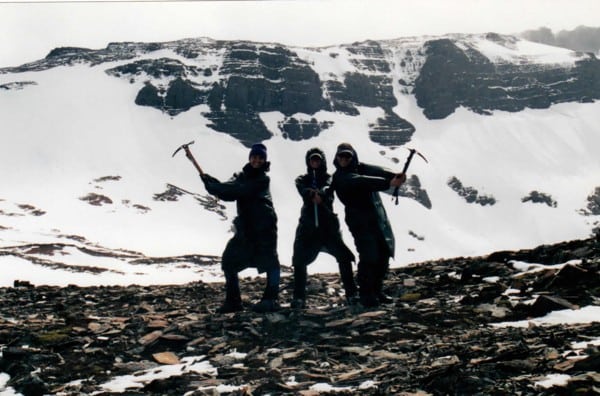
Megan and friends, ice-axe antics, 2000.
